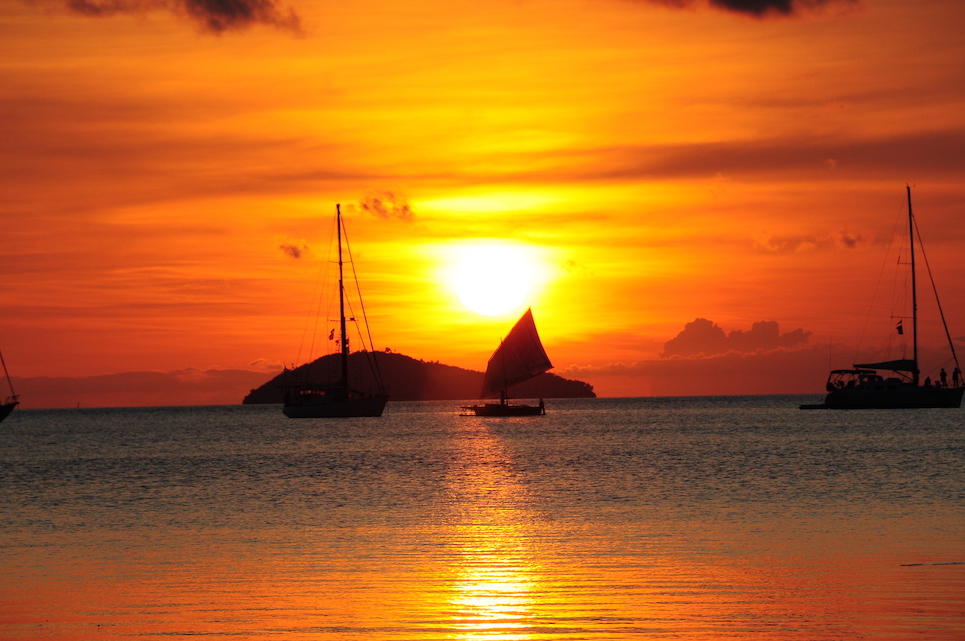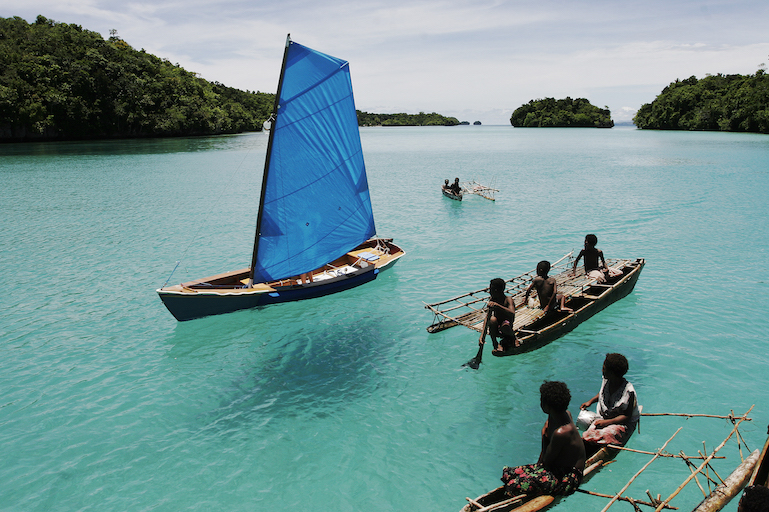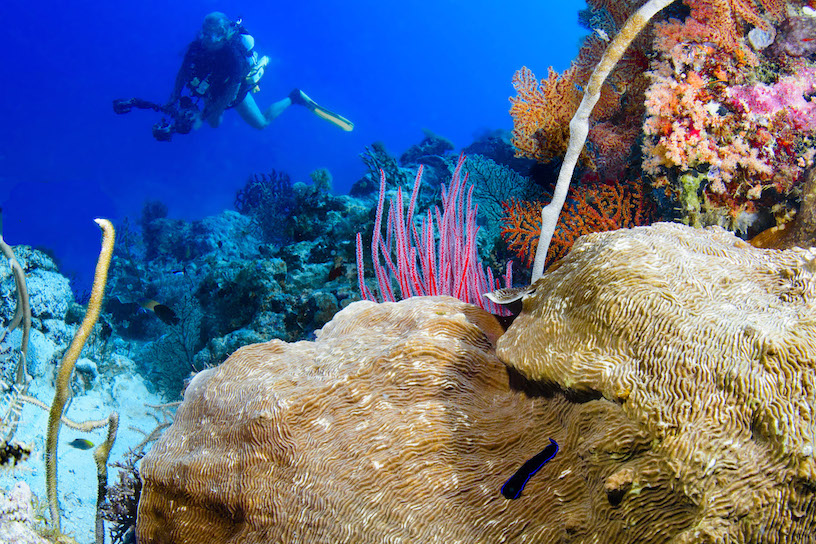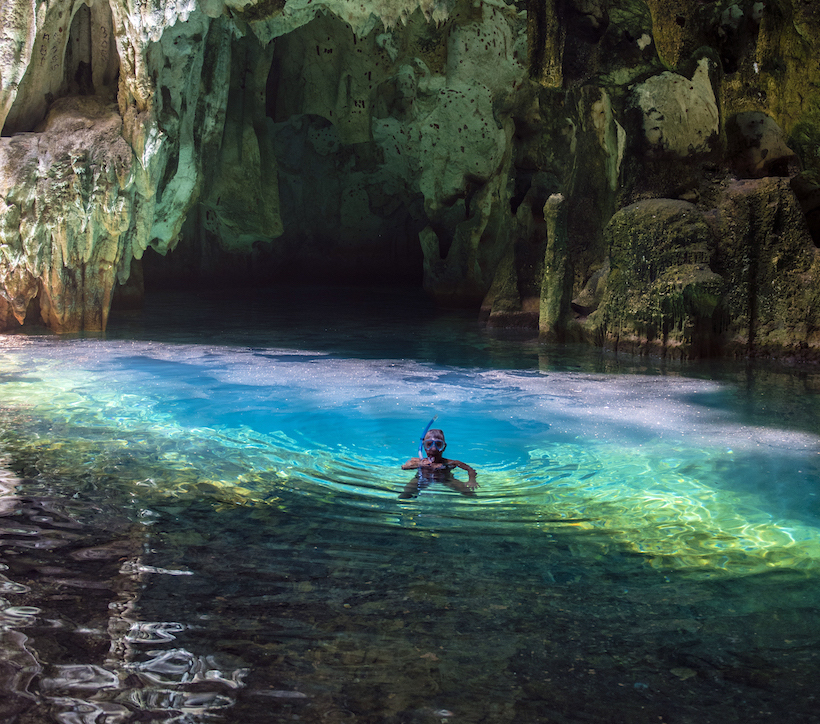Simple pleasures
The Louisiades are a string of stunning islands, reefs and lagoons within easy sailing distance of the coast of Far North Queensland. Anyone venturing there should be prepared for breathtaking seascapes and effusive local hospitality.
Written by Guy Chester
08 April 2019
Advertisement
Beautiful, remote, with a surfeit of natural attractions, the Louisiade Archipelago has for many years been a favourite stop for yachts cruising the Coral Sea and beyond.
The archipelago consists of a string of more than 90 islands, 100 nautical miles east of mainland Papua New Guinea and 520 nautical miles north-east of Cairns.
Stretching north to south over 160 kilometres, the group comprises sand cays, lagoon reefs, limestone outcrops (uplifted coral reefs) and continental islands with many safe anchorages. With abundant coral reefs, there is snorkelling, diving and fishing galore. The local people are exceptionally welcoming to yachts and will paddle out to greet visiting vessels and, of course, to trade.
I first visited the Louisiades during a short cruise after the 1991 Cairns to Port Moresby ‘Coral Sea Classic’ offshore race. In 2007, I spent two months cruising east from the PNG mainland to the Calvados Chain and Deboyne Lagoon.
Advertisement
It was at this time that the idea of the Louisiades Yacht Rally was born. We ran the event from 2008–2013, until cruising intervened for me. The area still beckons, though, and we hope to sail through the Louisiades on our way back to Australia (not for a few years though!)
Over the years of running the rally, supporting other cruisers transiting PNG, and developing programs for superyachts visiting the Louisiades, we have identified some key places. This is not supposed to be a definitive cruising guide – like Mark Twain said: “Explore, dream, discover”.
Passage notes
Leaving from Cairns is most popular, although Townsville is also a viable departure point. It’s a straightforward, nice reach across the south-east trade winds. Folk sail up from May onwards, but we found September and October the best weather for the passages out and back and for stable weather up in the islands.
The wind can get a bit fine on if the north-west-setting current is strong as you get closer to PNG. The best time to leave Australia is just as the front of the high is leaving the Australian coast as this gives more southerly quadrant in the wind. The further off the coast the high goes, the more east the wind goes, which can be a problem for the last 100 miles or so.
Arrival arrangements
See formalities below – if no arrangements have been made for special clearance, the port of entry at Alotau must be visited. If Misima clearance has been arranged, most boats head for Bramble Haven or the Duchateau Islands to start their cruise. These are both only occasionally inhabited and are a great place to recover from the passage. Think azure coral lagoons, coconuts and sandy beaches ashore.
It is likely you will soon be visited by folk sailing their traditional outrigger canoes, called sailaus. These sail at up to 15 knots and are the economic mainstay of the islands. Trade for lobster, fish and coconuts among the settled islands. You can also find tomatoes, tropical fruit and a wide variety of fantastic local handicrafts.
Take t-shirts, shorts, skirts, bras, fishing gear, woodworking and outboard fixing tools for trade. Even better, also take a supply of exercise books and pencils for the schools, early age readers and first aid supplies for donations. Folk need cash for school fees and other living expenses, so be prepared to buy some stuff – bring along some of the local currency, the Kina.
After the initial arrival its best to make your way to Misima Island for clearance. See the quarantine officer and await the arrival of the plane for customs. Misima once hosted a gold and silver mine that is now defunct. It’s a quiet happy place. The bakery is a must, as is lunch or dinner at the guesthouse.
Ports-of-call
All the islands are great to visit. My favourites are:
- After careful entrance to the lagoon (in the morning, with the sun behind you), ask to see the limestone cave on the south side. Go around by dinghy – or the intrepid can climb the limestone cliffs over the island. Even take the dinghy to nearby Little Panasia and visit the two families who live there. They may choose to show you a skull cave.
- Bagaman Island is the home to some exceptional carvers. They collect ebony from one island and bring it home to carve. For past rallies, the school has put on a great sing-sing (a gathering of tribes or villages to share dance and music), so if a few yachts are visiting together, ask and it may be a fantastic day.
- Pana Numara (Hober Bay) is a fun little island with a very welcoming community. They make exceptional handicrafts and are keen to show you how these are made. Help out making a mat, weaving a hat or making a shell necklace called baggi in Misima, the local language.
- The blue lagoon, just south of Pana Numara, is not to be missed. It has easy entrance, and is a great experience.
- Nimowa Island has a Catholic mission and a well-run clinic. It’s great to visit and over the years the rally and expedition cruise ships have provided support to the clinic, the only one within the Calvados Chain.
- Sabara Island is one of my favourites, with a tiny entrance to a very shallow lagoon where you nestle amongst the limestone cliffs. The little village on the lagoon will welcome you. Ask the kids to walk you over to the school on the northern coast.
- Kamataal – A journey to the Louisiades wouldn’t be complete without visiting Kamataal and meeting Jimmy. All islands have great folk who will befriend you, but Jimmy is one of a kind. He built a yacht club, and yes the yachties do come.
- Deboyne Islands – to the north of the Calvados Lagoon are the Deboyne Islands, with their own lagoon. There are various charted passages in and out of both lagoons, the least concerning is called Wuri Wuri Pass. I try to take the major passes when the light is best (around midday) and certainly not when looking into the sun. Panapompom is my favourite of the Deboyne Islands, with many very welcoming folk. Nearby, Deboyne itself is where the master canoe builders reside and you will doubtless see a few sailaus under construction. Don’t miss snorkelling over the WW2 wreck of the Japanese Zero that was deliberately crashed into the sea in 1942.
The above is only a snapshot; there are many other islands to visit. The more adventurous can go north, to Budi Budi, Woodlark and the Trobriand Islands, which are easily within the range of a two-month cruise. Budibudi is spectacular, with very isolated folk. Take a lot of trading and donation goods as they don’t get many visitors.
louisiades.net
pngcanberra.org/visas/
Advertisement
Advertisement
Advertisement






